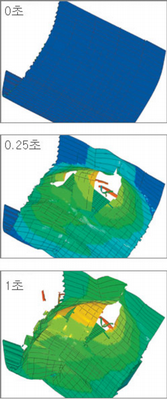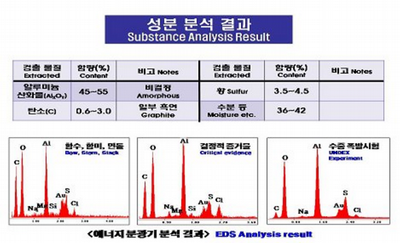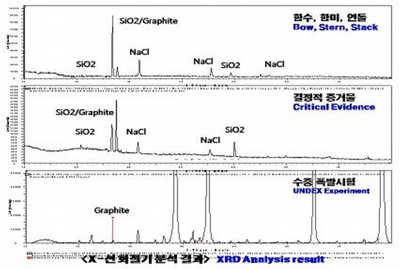Policy Forum 10-039: July 15th, 2010
By Seunghun Lee and J.J. Suh
——————–
CONTENTS
I. Introduction
II. Article by Seunghun Lee and J.J. Suh
III. Citations
IV. Other Resources
V. Nautilus invites your responses
Seunghun Lee and J.J. Suh, “Rush to Judgment: Inconsistencies in South Korea’s Cheonan Report,” The Asia-Pacific Journal, 28-1-10, July 12, 2010.
http://www.japanfocus.org/-JJ-Suh/3382
The views expressed in this article are those of the author and do not necessarily reflect the official policy or position of the Nautilus Institute. Readers should note that Nautilus seeks a diversity of views and opinions on contentious topics in order to identify common ground.
Other Nautilus publications on the Cheonan Incident:
The Cheonan Sinking and a New Cold War in Asia
Not only did the JIG’s press conference simulation fail to show that the bubble effect could have cut the Cheonan, that simulation is not consistent with the pattern of the ship’s damage. If the bottom of the ship was hit by a bubble, it should show a spherical concave deformation resembling the shape of a bubble, as the JIG’s own simulation suggests (see the right side of Figure 1), but it does not. The bottom of the front part of the ship is pushed up in an angular shape, as the yellow line shows in the left side of Figure 1, more consistent with a collision with a hard object. The tear line in the JIG simulation has a circular shape because the hull shows a tear in the area that was hit by the spherical bubble. Equally important, if a bubble jet effect was produced by an outside explosion of 250kg of explosives, as the JIG argues, that explosion should have produced an immediate pre-bubble shock wave whose strength would have been at least 5000 psi (pounds per square inch) when it hit the bottom of the Cheonan. 8 The bottom and ruptured surface of the ship betray no sign of such a large shock (compare Figure 1 with Figure 2 that shows the damage done by 5 psi on a house); the internal instruments and parts remain intact in their original place; and none of the crew members suffered the kind of injuries expected of such a shock (Figure 3). Given that an underwater explosion produces both a bubble effect and a shock wave and the latter is usually about 6 to 10 times as destructive as the former, the ship’s and the crew’s condition is not consistent with the damage expected of an outside explosion. 9
Even if the JIG could produce a simulation that shows the bubble effect severing the Cheonan, it is no proof that there was indeed an explosion that produced the bubble effect. Proof depends on a pattern of ship destruction that is consistent with a bubble effect simulation. But at this point, the JIG’s May 20 press conference simulation did not show the ship’s severance and a bubble effect simulation leading to severance has not yet been completed by the ROK defense ministry’s own admission. Moreover, the May 20 simulation is not consistent with the ship’s deformation. The JIG’s so-called first finding, therefore, is a mere allegation that is groundless and contradicted by the JIG’s own evidence and at least one analysis of underwater explosions in the military literature.
Third, although the JIG presented the torpedo parts recovered from the area of presumed explosion as “critical evidence” that tied the explosion to North Korea, the “critical evidence” has a serious inconsistency that casts doubt on the integrity of the evidence. The outer surface of the torpedo propulsion unit that was found was greatly corroded, presumably because the coat of paint that would have protected the metal had been burnt off during the explosion. The paint burn-off and resulting metal corrosion are consistent with a high heat explosion commonly found in bombs and torpedoes. And yet the blue ink marking of Hangul – “1b?n” in Korean – remains intact despite the fact that ink has a lower boiling point, typically around 150 degrees in Celsius, than paint does – typically 350 degrees Celsius – and thus the ink marking should have burnt away just like the outer paint. Our simple estimates suggest that the torpedo would have been subjected to heat of at least 350 degrees Celsius and quite likely over 1000 degrees, high enough to burn the paint and thus the ink as well. This inconsistency – the high heat tolerant paint was burnt but the low heat tolerant ink was not – cannot be explained and casts serious doubt on the integrity of the torpedo as “critical evidence.”18 Furthermore, both North and South Koreans can write the Korean letter “1b?n”, and thus we doubt that a regular court of law would consider the mark evidence of exclusive North Korean writing.19
In conclusion, the JIG had the burden of demonstrating beyond reasonable doubt all three of its findings in order to substantiate its conclusion that the DPRK’s torpedo destroyed and sank the Cheonan, but each of the three findings contain serious inconsistencies. Given that all three key claims have serious flaws, the JIG conclusion based on these claims is at least as seriously marred. While we emphatically note that our findings do not prove that North Korean did not do it, we conclude that the JIG has failed to prove that it did. The seriousness of the inconsistencies in fact casts doubt not only on the validity of the JIG conclusions but also on the integrity of its investigation. We suspect that at least some of the EDS data was fabricated, and recommend that an impartial board be formed to verify the integrity of the JIG data.
III. Citations
1 The May 20th report released by the ROK is actually an interim report. It plans to issue the final report by the end of July, 2010. Not only did the ROK government rush to judgement on the cause of the Cheonan incident, as we argue in this article, but it has also rushed to punitive measures against the DPRK, including urging the United Nations Security Council to act on the basis of the interim report.
2 One of the 3 civilian experts, recommended by the opposition Democratic Party, was expelled from the JIG before it released its report. The person expelled was then charged by the South Korean Navy with “defaming” it for propagating the “false allegation” that the Cheonan had been grounded. Kim Kwik?n, “Haegun, sinsangch’?lwiwon ‘my?ngyehueson’ hy?m?i koso [Navy Charges Shin Sang-Chul of ‘Defaming’ It,”] Yonhap News, May 19, 2010.
3 CSI or Crime Scene Investigation is a popular U.S. TV series that depicts police use of advanced forensic and scientific techniques to investigate and solve crimes.
4 Yun D?kyong, co-chairman of the JIG, admitted at the hearing of the Parliament’s Special Committee on the Cheonan on May 24 that “we are continuing our simulation and the final result of the simulation will come out in July,” conceding that “the simulation is not yet completed to show the water column [that is allegedly produced as a result of the bubble effect], but it will be all shown when the simulation is completed.” Pak J?ngi, another co-chairman, added that “the Korea Institute of Machinery and Materials [that is in charge of the simulation] said it would complete the simulation by July 15th.” Kim Namgwon and Kim P?mhy?n, “Kimgukpang, ‘Puk, simnij?n konggy?khamy?n ch?kkak tae?ng [Defense Minister Kim, ‘Will Immediately Respond if North Attacks [Our] Psychological Warfare’],” Yonhap News, May 24, 2010. The latter quote is from “Ch’?anhamt’?kwi, ‘mulgidung chonjaey?bu’ nonnan [Cheonan Special Committee, Controversy over ‘Presence of Water Column’], Yonhap News, May 24, 2010.
5 The JIG’s simulation results are available here. Although the ROK defense ministry (MND) has updated the simulation, as of July 2, 2010 it still fails to show how the Cheonan was severed.
6 Suh Jae-Jung, “B?b?lhyogwan?n ?bss?tta [There was no bubble effect],” Pressian, May 27, 2010. Ch?n Tonghy?k, “P’okbalhu 1ch’okkaji … ch’?nanham paemit ir?tke jjig?r?jy?tda [Up to a second after explosion … The Chonan’s bottom deformed this way],” Dong-a sai?ns? [Dong-A Science], May 28, 2010.
15 S.-H. Lee and P. Yang, “Was the “Critical Evidence” presented in the South Korean Official Cheonan Report Fabricated?” June 28, 2010.
18 The JIG argues that when the torpedo exploded, it produced heat higher than 3000 degrees Celsius and that aluminum powder in the explosive material melted and transformed into amorphous aluminum oxides, which bonded with the propeller of the torpedo. Since aluminum oxides in powder form cannot bond with another metal, it must be in liquid state. Given that aluminum’s melting temperature is 660 degrees and aluminum oxide’s melting point is 2000 degrees Celsius, the rear part of the torpedo must have been subjected to heat of at least somewhere between 660 and 2000 degrees Celsius, if the JIG claim is right. Whether 660, 2000 or 3000 degrees Celsius, it cannot be scientifically explained that none of this heat affected the ink marking.
19 The ROK defense ministry reported on June 29 that the ink is made of “solvent blue-5.” Recognizing that it is a common ingredient used in markers worldwide, the ministry conceded that “it might be difficult to conclude that the ink is made in North Korea.” A military official added that the result of the ink analysis will not be included in the final report on the Cheonan incident due to be completed by the end of July. “’1b?n’ingk?s? solbentb?lu5 s?ngbun g?mch’ul [Solvent Blue-5 Detected from ‘1b?n’ Ink],” Yonhap News, June 29, 2010.
Seunghun Lee presentation on the “No. 1” mark:
http://www.youtube.com/watch?v=fh8apCZUODw
J.J. Suh’s presentations:
http://www.youtube.com/watch?v=YJuyuM555gY
http://www.youtube.com/watch?v=aceTwog6UDA
Seunghun Lee presentations:
http://www.youtube.com/watch?v=XpZSHTon1b8
http://www.youtube.com/watch?v=DGeZ-ZQGEic
V. Nautilus invites your responses
![]() The NAPSNet Policy Forum provides expert analysis of contemporary peace and security issues in Northeast Asia. As always, we invite your responses to this report and hope you will take the opportunity to participate in discussion of the analysis.
The NAPSNet Policy Forum provides expert analysis of contemporary peace and security issues in Northeast Asia. As always, we invite your responses to this report and hope you will take the opportunity to participate in discussion of the analysis.









